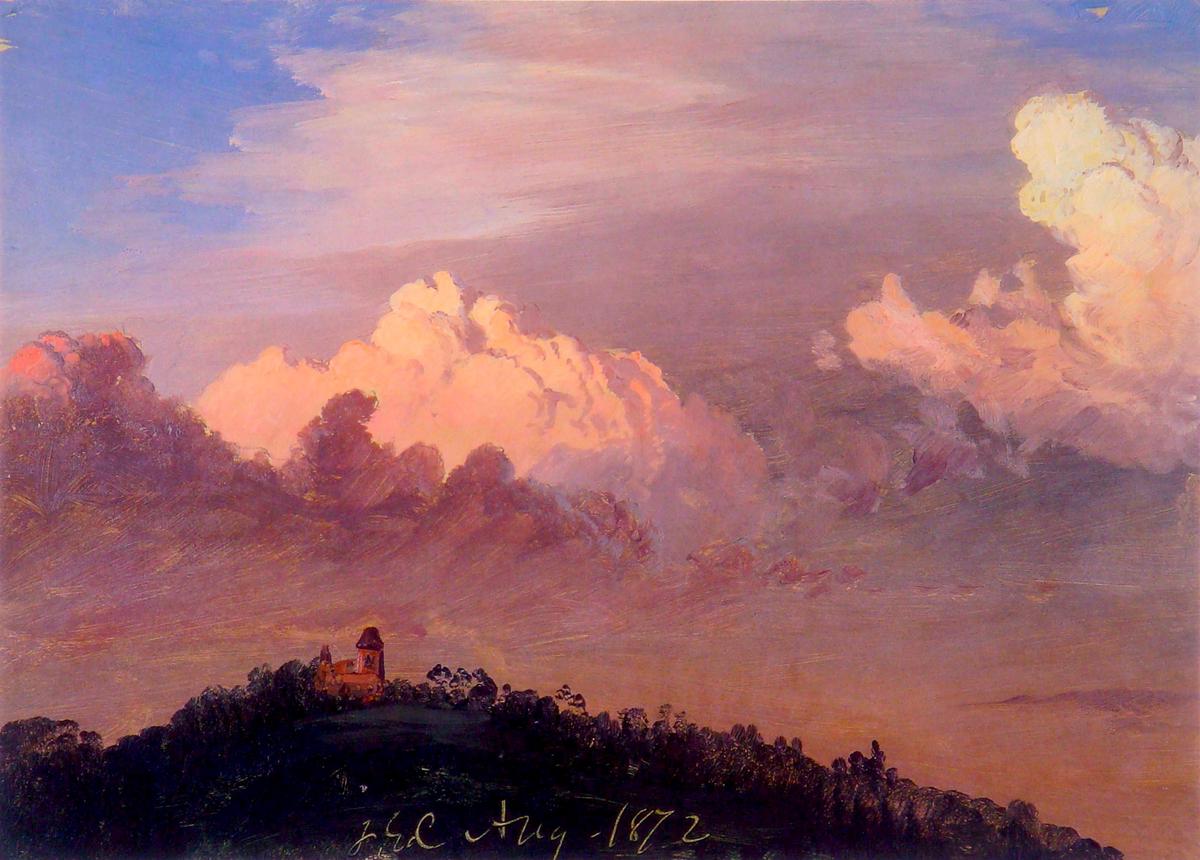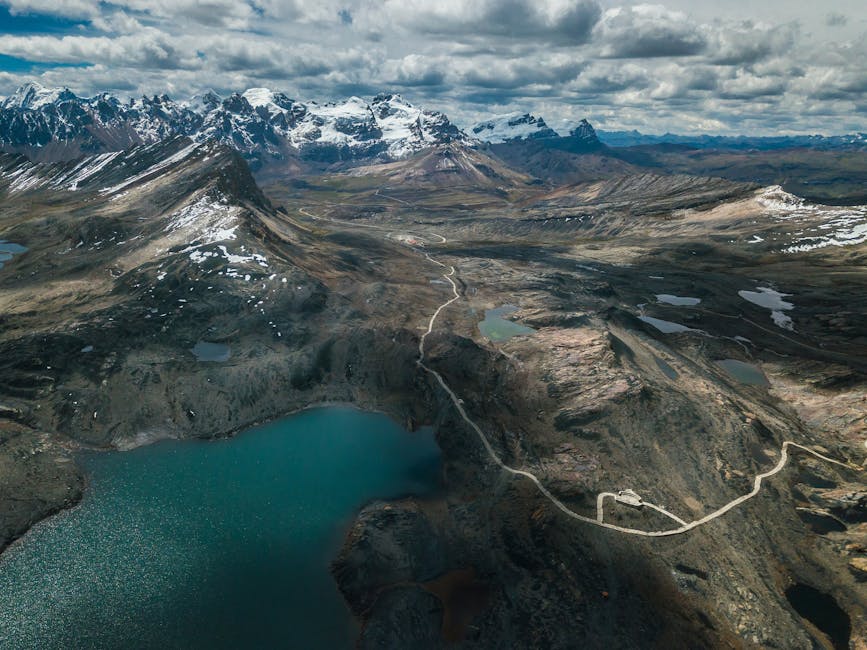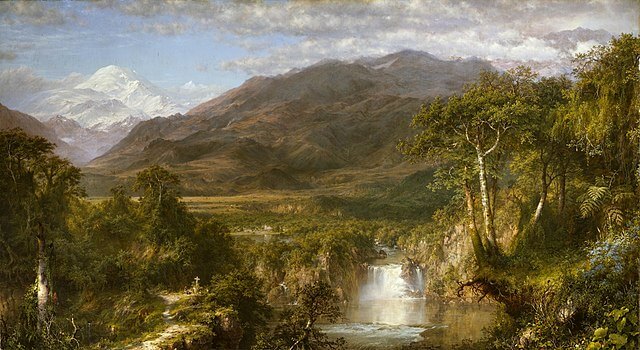Historical Context and Creation
Frederic Edwin Church, a key figure of the Hudson River School, wasn't just painting landscapes in the 1850s; he was capturing the essence of an era brimming with exploration and discovery. Church's life was a reel of wanderlust and artistic drive.
Born in Connecticut in 1826, he was an apprentice of Thomas Cole, a titan of landscape painting. This mentorship laid the groundwork for Church's fearless venture into uncharted territories. Church traversed the rugged terrains of South America multiple times in the early 1850s, amassing the raw essence that would later bleed into his magnum opus, 'Heart of the Andes'.
These excursions were intense sessions of documentation, deeply influenced by the works of the scientist Alexander von Humboldt. Humboldt's explorations and writings about the unity of nature served as a scientific bedrock for Church.
The painting, a staggering 5 feet by 10 feet of oil on canvas, is a spectacle of earthly and celestial harmony. Every inch of 'Heart of the Andes' is brimming with detail—each tree, plant, and mount is painted with a level of accuracy that would make a botanist proud. This painting mirrored the era's scientific curiosity and underscored the global push for exploration and deeper understanding of the natural world.
When 'Heart of the Andes' was first exhibited in 1859 in New York, Church set the stage with curtains framing the painting like an otherworldly vista from a window, the gallery dimmed, the artwork spotlighted. Viewers, armed with opera glasses, paid a fee to marvel at the intricate wonders of the Andes, all from a padded seat in New York City. Attendees were sucked into the adventure, without the bone-chilling cold or grueling hikes. They could practically smell the Andean flora that Church had replicated in the gallery with real plants.
The mid-1800s were buzzing with geographic discoveries, and Humboldt's call to artists to capture the "physiognomy" of the Andes landed squarely with Church. 'Heart of the Andes' stood as a colossal response to that call, blending scientific precision with unparalleled artistic beauty.
Church's commitment to realism in 'Heart of the Andes' also reflects the early strains of tourism. As the world opened up to travel, people craved experiences and mementos. Grand exhibitions were becoming the norm, and Church capitalized on this trend by turning his art into immersive journeys.
Church continued to push boundaries, showing his work on both sides of the Atlantic, ensuring he wasn't just a local favorite but an international phenomenon. The painting, upon its grand unveiling, sold for $10,000—a hefty sum and the highest price ever paid for a work by an American artist at the time.
'Heart of the Andes' stretches into geography, science, and cultural expression. It's a living document of an artist's journey, a tribute to an age of discovery, and a panoramic homage to a world just beginning to reveal its secrets.

Artistic Techniques and Analysis
Just as a maestro carefully crafts a symphony with each note resonating perfectly, Frederic Edwin Church orchestrated 'Heart of the Andes' with an array of artistic techniques that left an indelible impression on his audience. Standing before this panoramic marvel, one is struck by the harmonious interplay of light, color, and composition, each conspiring to etch the grandeur of the Andes into the annals of art history.
Church's use of light is particularly spellbinding, a hallmark of the Hudson River School and Luminism movement to which he belonged. Light in 'Heart of the Andes' isn't just a mere visual effect; it's the lifeblood of the scene. It breathes, cascades, and dances across the landscape, illuminating the peaks and valleys with a divine luminescence. This natural light bathes every element in a realistic glow, casting ethereal highlights and deep, shadowy recesses that make the viewer feel as if they've been transported to the Andean foothills.
Color plays a pivotal role in drawing viewers into the enchanting serenity Church painstakingly captured. The painting is a symphony of greens, blues, and earth tones, each thoughtfully layered to create depth and vibrancy. The palette harmonizes with the natural world, reflecting the lush vegetation of the Andes and the crystal-clear azure of Andean skies.
The composition of 'Heart of the Andes' is no less miraculous. Church uses the expansive canvas not just to display a single view but to tell a grand story of interconnected ecosystems. The painting's composition is truly a masterpiece of artistic storytelling, rooted deeply in Humboldt's principle of the 'unity in diversity'. Multiple vignettes coexist within the larger scene, each carefully rendered yet contributing to the cohesiveness of the entire landscape:
- Cascading waterfalls
- Serene pools
- Rugged boulders
Church's precision does not end with grand gestures; it's in the minutiae that his brilliance truly shines. His brushwork is a celebration of texture and structure, with individual leaves, stones, and water ripples rendered in exquisite detail. This level of detail reinforces the painting's scientific veracity and illustrative accuracy of the Andean environment, merging art and science seamlessly.
The careful integration of different elements exemplifies Church's vision of a unified landscape, presenting a total experience of nature's grandeur. This isn't a mere collection of pretty scenes; it's a holistic tableau that speaks of nature's interconnectivity and splendor.
Church's 'Heart of the Andes' doesn't just depict a scene; it invites the viewer into a spiritual immersion into nature's majesty. The use of light creates a living, breathing world. The colors, with their rich, detailed vibrancy, bring every leaf and peak to life. And the composition, masterfully arranged, crafts an experience that lingers long after one's gaze has reluctantly moved away. Church's techniques weren't mere artistic choices—they were an ode to the land he so fervently explored and loved.
Initial Reception and Impact
The grand debut of 'Heart of the Andes' in 1859 was nothing short of a sensation, a carefully orchestrated event that turned heads and hearts alike. Church's unveiling of the painting in New York City was an exhibition masterclass. Curtains draped around the colossal frame, shielding it from view until the precise moment of revelation. In that instance, with the gallery dimmed and the painting illuminated, an otherworldly vista unfolded before an eager audience.
The public reception was overwhelmingly positive. People flocked in droves to witness this marvel, ready to pay the admission fee and armed with opera glasses to scrutinize every minute detail of the expansive canvas.1 It was not mere viewing but an immersive journey, allowing viewers to traverse the peaks and valleys of the Andes without ever leaving their seats.
Critics lauded Church's work, heralding it as a new epoch in landscape painting. The blend of scientific exactitude and artistic grace that 'Heart of the Andes' encapsulated was nothing short of revolutionary. Esteemed art reviewers couldn't help but extol Church's ability to weave a canvas of nature that was as informative as it was enthralling.
The painting didn't just captivate America; it crossed the Atlantic and caused a similar stir in Europe. When exhibited in London, 'Heart of the Andes' drew throngs of art enthusiasts and curious onlookers. Londoners, already steeped in a rich tradition of landscape painting, found themselves mesmerized by Church's rendition of South American splendor.
Church's success with 'Heart of the Andes' paved the way for future grand exhibitions, turning landscape painting into a spectacle. This was more than just a painting; it was an event, a cultural phenomenon. Galleries took note, realizing the potential of such immersive presentations.
'Heart of the Andes' catalyzed the trend of artistic souvenirs. Visitors wanted more than just memories; they craved tangible connections to the experience. Prints of the painting, brochures, and even small-scale models became hot commodities.2 This commercialization of art souvenirs dovetailed perfectly with the burgeoning tourism industry, where travelers sought mementos that captured the essence of their experiences.
The influence of 'Heart of the Andes' on the art world was profound. It wasn't just about the awe-inspiring beauty or precise detail; it was about how art could encapsulate the spirit of discovery and exploration. Church's work inspired other artists to undertake similarly ambitious projects, blending scientific observations with artistic endeavors.
'Heart of the Andes' ushered in a new era of grand exhibitions and a thriving market for artistic souvenirs. It demonstrated the power of art to transport and educate, to inspire awe and curiosity. Church's masterpiece didn't just depict a landscape; it captured an era's spirit of exploration and wonder, leaving an indelible mark on the art world and the public imagination.
Cultural Resonance and Legacy
More than 150 years after its creation, 'Heart of the Andes' continues to influence artists, naturalists, and the broader cultural landscape. Church's masterpiece blends art and scientific observation, setting a precedent for interpreting the natural world through art. The painting serves as a didactic illustration, teaching viewers about South America's diverse ecosystems.
Contemporary landscape painters often cite Church's detailed technique and holistic vision of nature, aiming to replicate the grandeur and accuracy in their works. Naturalists find inspiration in the painting's alignment with Alexander von Humboldt's principle of the interconnectedness of nature. The intricate renderings of flora and fauna inform and educate, motivating naturalists to explore the harmonious intricacies of ecosystems.
'Heart of the Andes' has become a symbol of intellectual curiosity and discovery, fostering global connectivity and a hunger for understanding foreign lands and cultures. Church's portrayal of nature's splendor has played a significant role in environmental discourse, inspiring reverence and an urge to protect pristine environments. This influence permeates modern environmental art, with many artists drawing on Church's legacy to highlight ecological concerns and promote conservation.
The painting's imagery is utilized in documentaries and educational programs to discuss the Andes' biodiversity, reinforcing its role as a bridge between art and science. Church's immersive presentation style, with its use of framing, dimmed lighting, and viewer aids, prefigures modern multimedia installations that create all-encompassing experiences.
'Heart of the Andes' serves as a pivotal example in art history and natural science courses, demonstrating how art can convey complex scientific concepts and foster a multidisciplinary approach to learning. Ultimately, the painting stands as a testament to Church's vision and dedication, bridging the realms of art and science, aesthetics and knowledge, and illuminating the path for future generations captivated by the natural world's splendor and intricacies.

Modern Interpretations and References
In contemporary culture, 'Heart of the Andes' continues to inspire filmmakers, writers, and artists. Nature documentaries and epic dramas often draw upon Church's lush, detailed landscapes to frame their stories, echoing his dedication to capturing the untouched wilderness's sublime majesty.
Novelists and poets seek to evoke the same blend of awe and introspection that Church achieved, referencing his painting in stories of exploration, discovery, and the relationship between humanity and nature. The detailed descriptions of settings and lyrical prose mirror the scenes vividly painted by Church.
Modern landscape painters and mixed-media artists look to Church's work for technique and thematic depth. Installations in galleries and public spaces occasionally feature direct nods to his technique, integrating light manipulation and detailed representations of the natural world. Digital art and multimedia installations create immersive experiences that pay homage to and reinterpret 'Heart of the Andes' using advanced technology.
The painting's relevance in today's cultural context is underscored by its resonance within environmental and ecological discourse. Church's depiction of diverse ecosystems parallels contemporary environmental art and activism, serving as a visual statement about the fragility and beauty of our planet. Educational programming and curriculums frequently reference 'Heart of the Andes' to demonstrate the intersection of art and science, illustrating complex concepts through the accessible medium of fine art.
As we face new environmental challenges, 'Heart of the Andes' remains a powerful symbol of human curiosity and ecological awareness. The painting invites us to reflect on the historical context of natural exploration and recognize our ongoing relationship with these landscapes, urging us to maintain a delicate balance between admiration and responsibility toward the natural world.
'Heart of the Andes' continues to captivate and inspire, bridging the gap between art and science, past and present. Church's dedication to capturing the essence of nature serves as a reminder of our ongoing relationship with the natural world. This painting is not just a visual marvel but a lasting tribute to the beauty and interconnectedness of our environment.




















